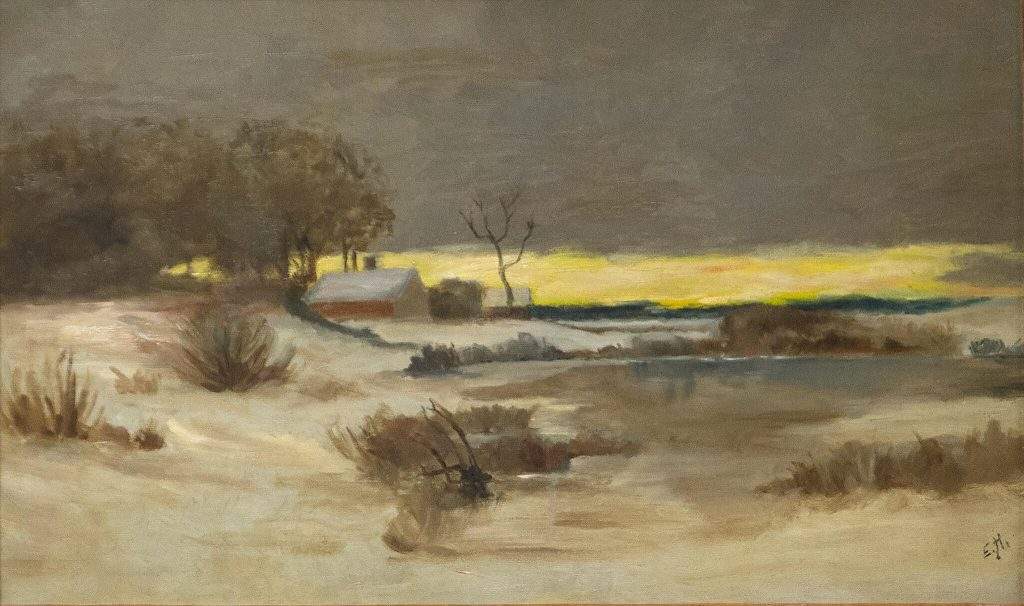Hopper's youthful paintings? They are copies from magazines for amateur painters
The early paintings of Edward Hopper (Nyack, 1882 - Manhattan, 1967) are all copies from paintings published in American magazines for amateur painters: this is the interesting discovery that a young doctoral student at the Courtauld Institute in London, Louis Shadwick, published in the latest issue of Burlington Magazine. Shadwick’s attention was focused on some paintings that Hopper made at a very young age, between 1895 and 1900, such as Old ice pond at Nyack (1898-1900) or Rowboat in rocky cove (1895), or even the painting Ships of about 1898 kept at the Fossaner Art Museum in Melbourne, Florida. These works were thought to be views made by Hopper in or around his hometown of Nyack (near New York City). But in fact they are landscapes that have nothing to do with Nyack and, “now it can be revealed,” Shadwick writes in his article, are copies of paintings by other artists, belonging to the Tonalist movement that developed in the late 19th century United States.
In particular, Old ice pond at Nyack is a copy of A winter sunset by Bruce Crane (New York, 1857 - Bronxville, 1937), depicting a Long Island or Connecticut landscape; Rowboat in rocky cove is a copy of a painting by an unknown artist, titled Lake view and probably set in Wisconsin; and Ships is a copy of a navy by Edward Moran (Bolton, 1929 - New York, 1901). All of these works had been reproduced in the early 1890s in the periodical Art Interchange, aimed at amateur and student painters: the magazine contained collectible plates and instructions on how to reproduce the paintings (for Crane’s painting they had been provided by the author himself and covered, for example, the choice of type of canvas, advice on how to draw, how to spread the color, and how to make it dry). Since the reproductions are found in different issues, it is likely that Hopper was a frequent reader or that his parents had subscribed for him.
The discovery is important because it gives us a clearer idea of Hopper’s career: “his beginnings, in fact,” Shadwick explains, “seem to have been more uncertain than previously thought.” Hopper did not indicate that his canvases were copies, but signed them with his name: “rather than an attempt to confuse,” Shadwick wrote, “the signatures simply suggest the artist’s youthful pride in his early achievements in oil painting.” There are, however, other interesting facts as well, which make clear Hopper’s implicit association with the tonalist landscape movement, something that reflects, Shadwick points out, the “great popularity of tonalism in the American market in the years immediately preceding the 20th century.”
“At this time,” the young scholar writes, “Tonalism was recognized as a style in all but name, defined by its nonnarrative emphasis on intimate and often pastoral American landscapes, its priority of the artist’s subjective response, and its great attention to atmosphere rather than detail. The impact of the Tonalists on modern American art is a subject that has yet to be recovered by scholars, but Hopper’s canvases provide a compelling example of the way he and his generation understood the American landscape genre through the prism of the Tonalist vision.” And his interest in this type of art thus reflects his approach to landscape: not to mention that, for Shadwick, the manner of approaching landscape typical of American Tonalist painting “would become a characteristic feature of Hopper’s work throughout his career.”
“Hopper’s early paintings,” Shadwick concludes, “will require further research, since the evidence presented here suggests an openness to a wider range of artistic sources than has usually been recognized. Indeed, the often inflexible categorizations of Hopper’s work perpetuated by his early critics left little room for the myriad, often incongruent influences that characterized the early part of his career.”
 |
| Edward Hopper, Old ice pond at Nyack (1898-1900; oil on canvas, 29.8 x 50 cm; Heather James Fine Art) |
 |
| Bruce Crane, A winter sunset (1880s; reproduction from The Art Interchange magazine, December 6, 1890) |
 |
| Edward Hopper, Ships (ca. 1898; oil on canvas, 30.5 x 50.8 cm; Melbourne, Florida, Fossaner Art Museum) |
 |
| Edward Moran, A marine (1880; reproduction in The Art Interchange magazine, August 14, 1886) |
 |
| Hopper's youthful paintings? They are copies from magazines for amateur painters |
Warning: the translation into English of the original Italian article was created using automatic tools. We undertake to review all articles, but we do not guarantee the total absence of inaccuracies in the translation due to the program. You can find the original by clicking on the ITA button. If you find any mistake,please contact us.




























